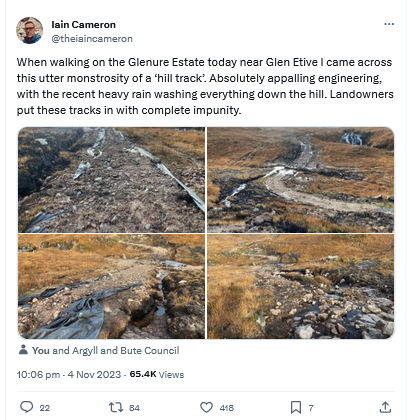 A week ago Iain Cameron copied me into his tweet on a track on the Glenure Estate on the eastern side of Ben Sgulaird. He was right, it is monstrous. His tweet has now attracted over 65K views, an indication of the level of interest from people in what is happening to the landscape of the Highlands, with some people asking questions like whether it was connected to the Glen Etive hydro schemes and who were the owners of the estate?
A week ago Iain Cameron copied me into his tweet on a track on the Glenure Estate on the eastern side of Ben Sgulaird. He was right, it is monstrous. His tweet has now attracted over 65K views, an indication of the level of interest from people in what is happening to the landscape of the Highlands, with some people asking questions like whether it was connected to the Glen Etive hydro schemes and who were the owners of the estate?
I had seen the track earlier this summer on a walk from Glen Etive to Ben Sgulaird and back over Beinn Trilleachain in June via the Allt Bhiorain hydro scheme, the only one in of the seven in Glen Etive I had not visited. An excuse to blog about both!
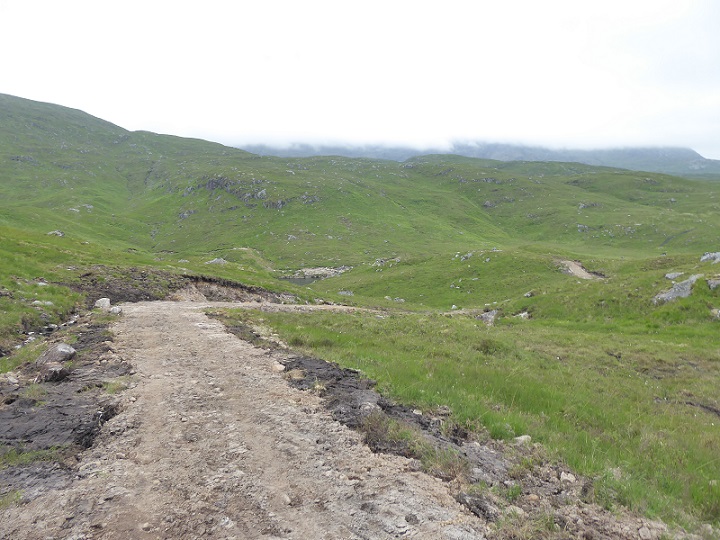
On that walk I had seen the same track that Iain recorded. There had been a track here previously and had recently been worked upon (I saw a digger in the distance and should have gone to have a closer look). A comparison with Iain’s photos suggests that five months later much of that work has been washed away.
There is nothing about the track upgrade on the Highland Council Planning portal and it appears whoever acted on behalf of the French owners of the Glenure Estate did so without seeking planning permission. Whether “upgrades” to tracks require planning permission is a grey area in the law but the fact this one has failed so disastrously is a strong argument that it should have been considered through the planning system. Highland Council’s Planning Enforcement Charter (see here– page 10) encourages the public to report unauthorised developments and has a form (see here) for reporting problems. If you want to do to so the Grid Reference is NNO 081465.

It would be unwise, however, to underestimate the difficulties of getting Highland Council to take any enforcement action when this monstrosity, just over the watershed in Glen Etive, did have planning permission. It is every bit as bad as I and others warned (see here). One of the problems is Highland Council planning department is so busy approving new developments, such as those for the dozens of telecommunications masts in remote areas, that it does not have time to monitor developments it has approved, let alone enforce conditions.
The Alt Biorainn hydro scheme
Of all the seven Etive hydro schemes (see here for planning application) I thought that the one that might have least impact would be the one on the Allt Biorainn, the river the curves round the north end of Beinn Trilleachain and joins the River Etive close to where it meets the sea. It is in a forestry plantation and out of sight from the floor of Glen Etive.
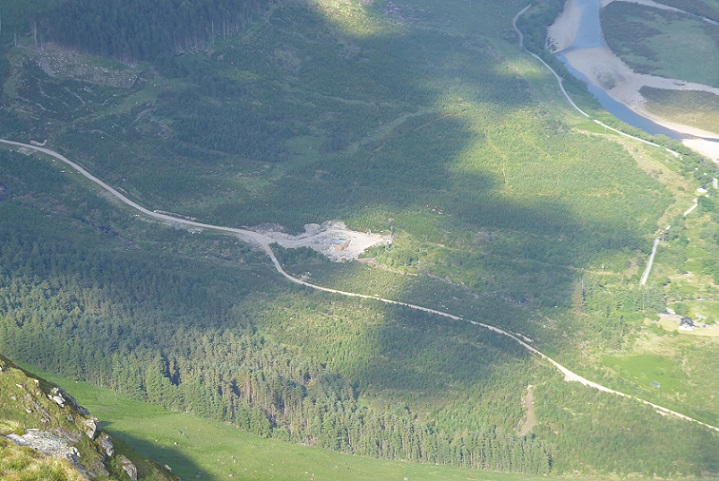
It turns out that even though I objected to this scheme I grossly underestimated the landscape impacts. Others were even less critical: the non-governmental organisations who failed to object to the hydro schemes on the west side of Glen Etive because they were not in a Wild Land Area, the consultants who prepared the visual impact assessments, the planners who considered these and the councillors who took the decision to approve this scheme. Do any of them believe this is acceptable?
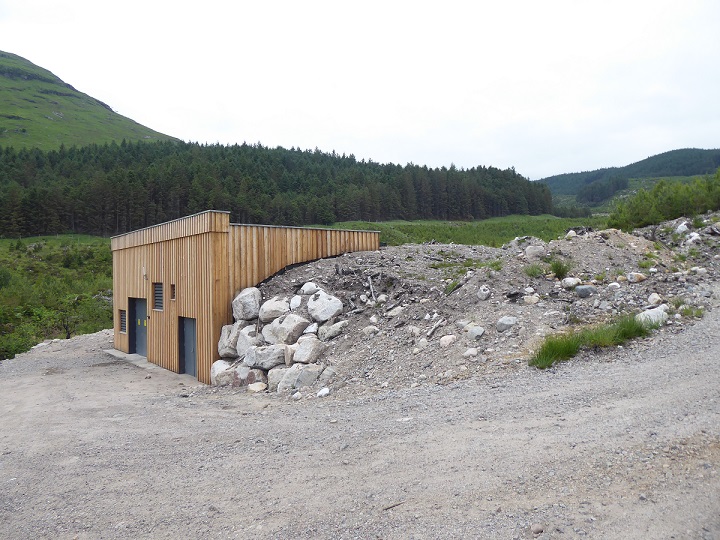 The powerhouse was meant to be buried to conceal it from view but is still surrounded by an unrestored construction site which makes it even more visible from afar and from on high.
The powerhouse was meant to be buried to conceal it from view but is still surrounded by an unrestored construction site which makes it even more visible from afar and from on high.
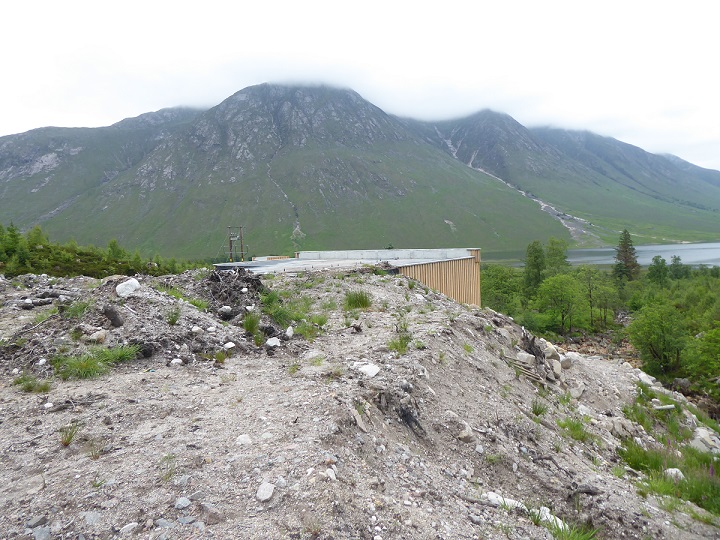
Glen Etive is meant to be a National Scenic Area. To the shame of Scotland that designation has become utterly worthless as the financial interests of developers are valued far more highly than what what were meant to be our finest landscapes.
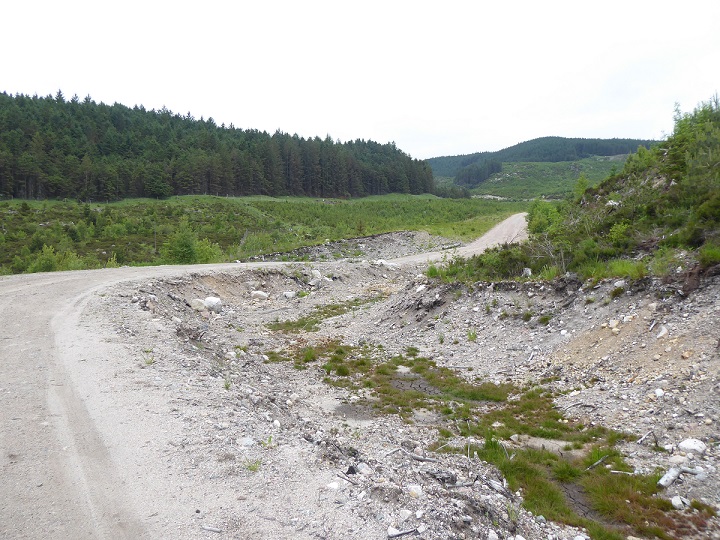
The developer has made almost no attempt to restore the land affected by the construction of the hydro. With industrial forestry plantations having already severely damaged the qualities of the National Scenic Area, more care needed to be taken not less.

On my visit there were surplus materials everywhere, apparently abandoned. So much for these schemes contributing to Scotland’s circular economy. There was no sign of machinery or any recent work on the site.
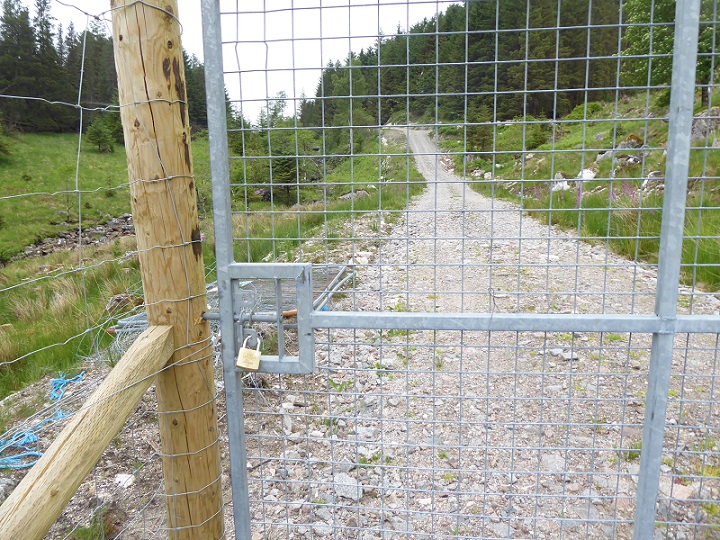
The extension of the forest track system up the Allt Biorainn potentially offered a new route over to Ben Sgulaird from Glen Etive, using forest rides above the hydro intake. But why would people want to walk through what is mostly an unfinished building site?
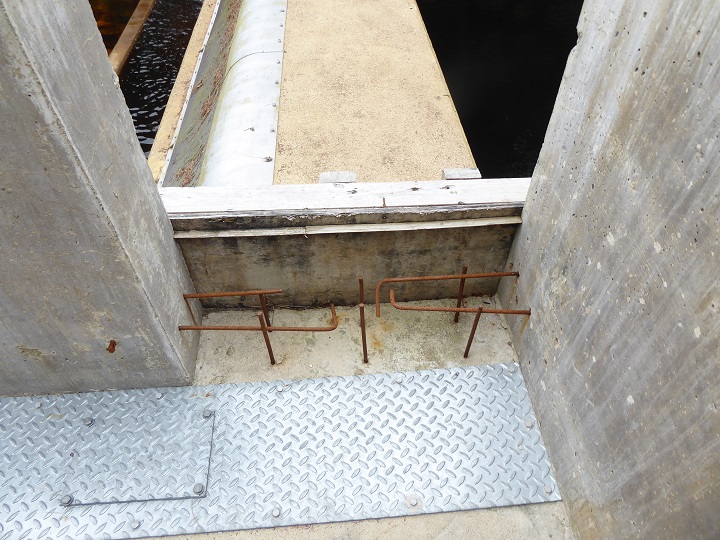 The concrete sides to the intake were unfinished, although the hydro appears to have been commissioned (earning money) and to have been operating before the dry period.
The concrete sides to the intake were unfinished, although the hydro appears to have been commissioned (earning money) and to have been operating before the dry period.
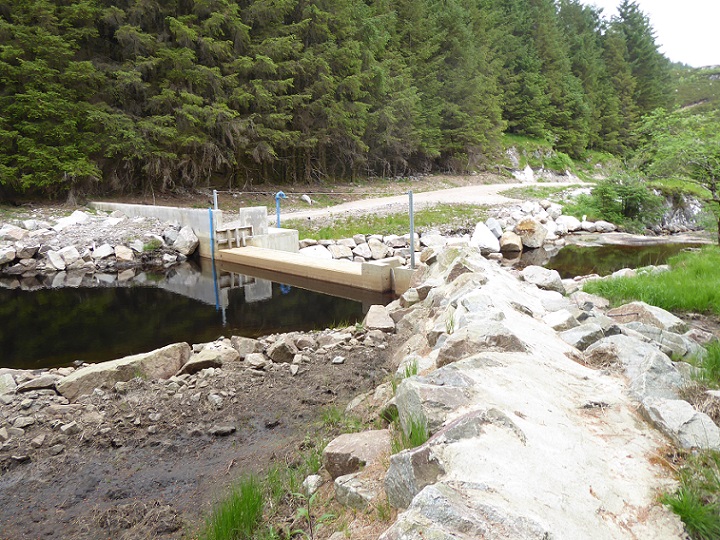
There has been very little attempt to landscape the intake – why bother when it is at present concealed by trees and behind a locked gate? The Alt Biorainn is not a true run of river hydro scheme because the intake has dammed the water upstream:
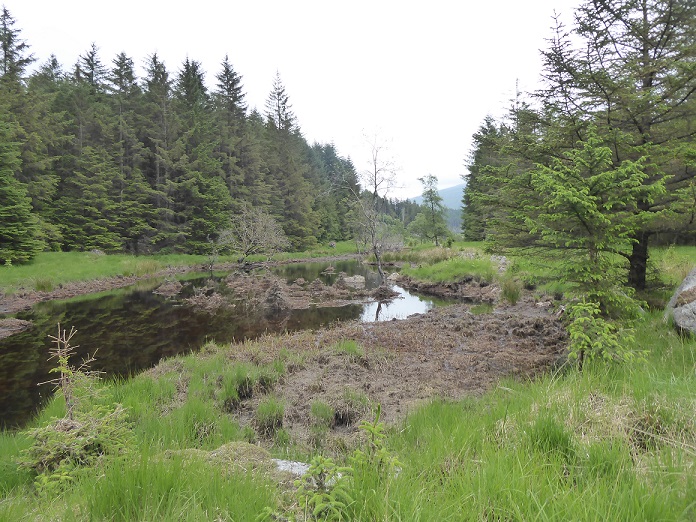
The rise and fall of water behind the intake has already killed some of the trees that had seeded in the space along the river and will eventually kill off the vegetation exposing the peat and releasing more carbon into the atmosphere. That is on top of all the other carbon released into the atmosphere through constructing the scheme in such a remote location.
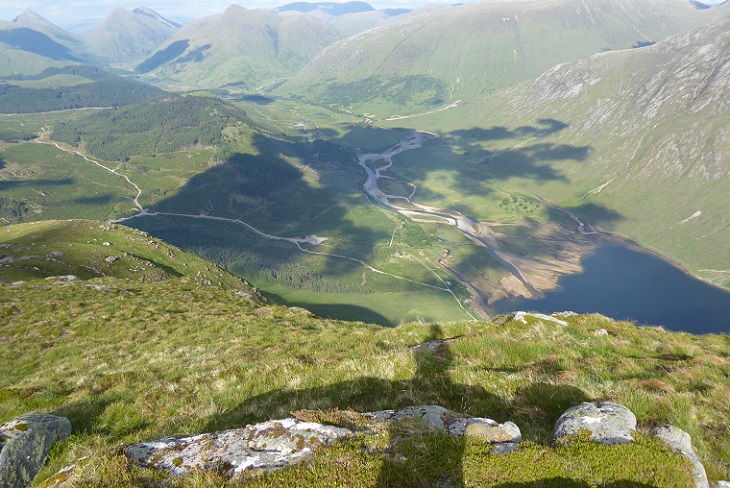
The forestry track left middle ground was widened to construct the hydro but would probably have been widened anyway – without any requirement for planning permission – to enable the timber to be harvested. Even if Save Glen Etive had won the hydro battle they would then have faced another………….and another………….and another. The whole system is stacked against the natural environment in Scotland and in favour of development interests.
Discussion
On Sunday I was at the Revive Conference in Perth compered, by Chris Packham, who is driven by the fact that the efforts of tens of thousands of people to protect nature have not worked. His argument was that we need to re-think how we campaign if it is not having sufficient impact. There is no point continuing to try and so the same.
The Glenure hill track and the Alt Biorainn hydro scheme are cases in point. Playing a failed planning system simply won’t change anything as I argued in my recent post on telecommunications masts (see here).
One question we might usefully ask therefore is how do we harness the energy and creativity of the 66k people who have looked at Iain Cameron’s photos of the Glenure tracks and empower them to be a positive force for change? What difference could they make to the plans to cover some of Scotland’s wildest areas with masts and tracks? Discussion please.
Scottish upland tracks are often poorly constructed and with little or no consideration for visual appearance.
Several publications exist that offer ‘best practice’ guidance on track construction and maintenance.
The SNH publication is particularly comprehensive – “Constructed Tracks in the Scottish Uplands”.
https://timbertransportforum.org.uk/wp-content/uploads/2021/11/SNH-Publication-2013-Constructed-Tracks-in-the-Scottish-Uplands.pdf
Empower Scots to put their money where their mouth is so they can buy back their country. Establish a buy back legal framework based on wellbeing, nature & fairness. I’m up for selling our house and chucking £400k into the pot. Anyone else? Get a Scottish Environment Court up and running now – there are plenty of other countries with Environmental Courts around the world. Pick the most effect variant and replicate it here.
I found this post so contradictory and especially when taken with so many of your other posts. The Glen Etive hydro schemes will produce carbon free electricity and thus make a contribution to the climate crisis in just the right way. Similarly the new tree planting visible in the photos is clearly the kind of planting you want in comparison to the older single species sitka stands also visible in the pictures. However hydro schemes and trees have one thing in common- they need access tracks to maintain them and in the case of trees ultimately harvest them. Even trees in semi re-wilded areas need access for deer and other management purposes. Even the flooded areas where yes there will be some carbon release are no different to flood areas created by the beavers that everyone, especially Chris Packham seems to love so much these days, and they seem quite modest. This looks like a good Hydro scheme. Whilst I agree that tracks should be built and maintained properly – it looks like they opted for a low cost/ low carbon track, compared with forestry standard road which as everyone knows is built to a higher standard and is therefore wider, bigger a worse scar and more carbon producing. I agree that the track hasn’t worked at all well and the owners need to think again. But having a go at the owners for investing huge sums in the estate, taking a risk on carbon reducing schemes and investing in better forms of planting seems a bit harsh. Yes they need to get their act together and tidy up, remove rubbish, and re-allow access now the plant is in operation but generally it looks like they and probably the planners too are trying to do the right thing. And generally these things are done better in private ownership than in state ownership or the hands of Chris Packhams quasi sate sponsors, such as RSPB, Forestry Scotland etc
Hi Colin, one wind turbine would produce as much electric as all 7 hydro schemes. The landowner has no direct responsibility for this having leased the land to the developer. The investment all ultimately comes from bank loans and requires almost noone to put their hands in them pockets. .on the continent they harvest forest roads like this.
I have seen many run-of-river hydro schemes in hill country over the past few years. With perhaps two or three exceptions, the tracks are hopelessly over-engineered for their purpose, NOT restored by the developer – I’m talking years after the schemes had been commissioned – and the weirs are clumsy monstrosities blighting some very fine landscapes that should never, ever, have been touched by development. Planners, in my experience, are very little moved by such concerns and seek only to implement SG planning policy, which is shockingly weighted in favour of development, regardless of environmental or landscape impact. No-one bothers to check the results and enforce restoration commitments. Estate owners knew they were tapping into a subsidy goldmine with ROR, and in they all jumped. It’s too late to say they “need to get their act together and tidy up”. The damage is done and it can never be rectified. I stared in horror at the mess in Glen Creran and Glen Ure when climbing Fraochaidh recently. No hope of restoring that. And the photograph of the desecrated Allt Mheuran in Nick’s post is too sad to bear. All that destruction in Glen Etive for a tiny quantity of electricity that could have been obtained from other, far less damaging sources – absolutely unjustified, in my view.
The climate crisis is bullshit. Carbon footprints, net zero all money making schemes.
It is a monetising scheme for a handful of liars such as Klaus Schwab and Bill Gates.
All the people I ask tell me the atmosphere is made up of 10, 20 ,50% carbon. This terrible. We’re all doomed.
In actual fact there is just 0.04% co2 in the atmosphere. If it drops to 0.03 then vegetation will die off. The whole things a con.
You tell a big enough lie often enough everyone will believe it.
Doug, with respect I think you have fallen into what I would describe as the Capitalist trap. The climate crisis is far from bullshit but where you are right is that instead of addressing the causes of that crisis a section of capitalist interests have siezed “net zero” as a money making opportunity as I have tried to document on these pages. Meantime, other capitalist interests are digging out fossil fuels like there is no tomorrow. I am not that surprised the people you talk with think CO2 makes up such a large percentage of the atmosphere, its not in the interests of the current system that people are well informed. The point here is that while CO2 (and other greenhouse gases) makes up a tiny proportion of the atmosphere they have a very big effect, they make life possible but what may appear to be tiny increases in those proportions (which is well documented and is proven to be linked to the burning fossil fuels) will also make large areas of the world uninhabitable (due to sea level rise, desertification etc). That is not bullshit and I suggest you read more about the science.
Grid ref NN081465, and this track generally, would appear to be in Argyll & Bute Council.
As a general comment on how to get HC to take notice of planning breaches… Reports/complaints need to be submitted by those people who are local – how local I’m not sure, but a campaign of letter writing from the central belt will get ignored. If the response is non-existent (likely) or unsatisfactory then escalate to councilors to badger the officers. If that doesn’t result in action escalate to MSPs and MPs – The harder officers squirm when asked by council members or MSPs what’s being done the better. Unfortunately HC have trouble recruiting planning officers and little money to take cases to court. So stalling and ignoring are rife. For both planning applications and planning breaches you can’t just scream “I object”. It has to be on statements of actual concern, material considerations, or actual breaches of planning – quote the legislation or guidelines.
And then cross your fingers something sticks.
Having some idea of the passions generated by developments such as those described here, and the enormous public interest in our landscapes and wild places, I would be surprised if more direct forms of action did not get considerable support. Imagine the media and political interest that could be generated by a few hundred people marching down the road in somewhere like Glen Etive objecting to the destruction that is going on. I would certainly take part and I can think of lots of my friends who would almost certainly join me. I am aware that the issues of renewable energy and landscape and environmental conservation are likely to come increasingly into conflict and that finding the right line will not always be easy, but as a bare minimum we can demand that the environmental conditions imposed when developments are agreed are enforced and where they have not been met that appropriate remedial actions are mandated. We can’t contiue to stand by and watch as the sort of things you draw attention to take place and nothing serious is done about them. It needs organisation of course; I’d help, but experience indicates that I don’t have the skills needed for anything but a minor supporting role.
Nick, I too was at the Revive conference and sorry not to have met you. Revive is emerging as a potent force for the radical land reform that is required to deal with the many issues raised on these posts, including this one. I noted the comments by Lesley Riddoch in respect of how we currently approach problems: we rush ambulance-chasing style to the scenes of the ‘accidents’ instead of dealing with the causes of the ‘accidents’–the change of approach Chris highlights.
I was appalled at the contribution of Lorna Slater the so-called biodiversity minister. I am relieved that at least she is not in charge of a neuro-surgery unit.
There’s a small problem here. Well, two small problems. One is that the prime mover in desecrating Scotland”s hill country is the SNP. Homegrown. Responsible for the most ludicrous travesty of a planning policy ever witnessed in a democracy. The second is that, in many cases, these appalling ROR schemes have been actively welcomed by locals. Glen Etive is a case in point. This is not an example of wealthy foreign individuals or corporations forcing their damaging schemes on unwilling natives; local people are often vocal in their support of such schemes and openly hostile to the complaints people like us might make. There’s financial benefit in it for them. You might say that they would act differently if they became landowners themselves, but I firmly believe that, if the estates were broken up, there would be even more devastation caused by an infinitely greater number of small landowners wanting their own piece of the golden goose (except that that particular bird has now flown). Every effort was made to get the Etive schemes over the starting line, even when Covid delays meant they should have been buried. There is an appetite for this kind of destruction and it’s led by the Scots.
Jane, I was thinking more of a cooperative of people who have wellbeing, nature and fairness as their core principles. Not carving up big estates but rather buying them and joining them up to create landscape scale transformation with local people genuinely empowered to be part of the decision-making processes. A legal framework and working in partnership with local communities would be critical of course. It has already been well said that ‘All life depends on us’ (humans) and there is no sustainable route to nature restoration without local people fully participating.
It’s a tragedy that Scots in general throughout history have been so naive, powerless and indifferent to the true value of their country. Like many indigenous populations around the world, the Scots have been easy prey for the rich, powerful and ruthless. Many Scots have grown up with the hateful notion that Scotland is nothing but bog and rain, so they rush to the Airport and head for ‘anywhere but this’ as often as they can. It is incumbent upon those among us who are fortunate to have a measure of the true value of Scotland to stand up, put politics, personality clashes and personal gain to one side and work constructively together to restore Scotland’s nature. “If we don’t change direction, we’ll end up where we’re headed.” Chinese proverb.